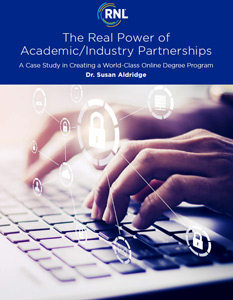enrollment
The Real Power of Academic/Industry Partnerships
Dr. Susan Aldridge has led some of the most successful “growth strategies” in higher education, and none more so than during the years she served as president of University of Maryland Global Campus (UMGC). Over the 20+ years I have focused on adult and online higher education, I often came across Susan’s name, and in recent years she has become a friend and informal advisor.
In a conversation last fall, Susan mentioned that she was planning on writing a white paper focused on how she led UMGC’s efforts to develop its first master’s program in cybersecurity. Nearly a decade later, UMGC continues to dominate this market—producing 939 graduates, one of only three programs to produce more than 200 graduates in 2020 among 159 different programs nationwide. In our conversation, we talked a lot about what drove planning decisions that resulted in this kind of success.
The development of the program was a reaction to the times: stagnant enrollment, an increasing reliance on tuition revenue, governance pressure to grow, and a belief that adults in need of higher education could provide the solution. Institutions find themselves in many of these situations today. Many are quickly embracing online education as their solution, but without the proper plan in place, Susan worries that many of these efforts could lead to less than successful results.
With this in mind, I asked Susan what she thinks are the most important best practices. We discussed many of these, but she said that none was more important than working with business and industry in the region (and beyond) in the field to ensure that the program you develop will meet their needs—and they will want to hire your graduates (and send some of their employees to the program if you’re lucky.)
Listen here to my conversation with Susan about how we leveraged the expertise and knowledge of employers and industry experts to build this highly successful program.
Susan really did lead this effort. One of Susan’s points in the paper is to demonstrate that presidential leadership can’t end at gaining board approval and finding the funding. Presidents need to be engaged in the entire process—both administrative and academic. Why? Because developing new programs is as much a business decision and process as it is an academic one. The financial health of an institution can be helped or hurt (if I’m being really honest), by the decisions that get made about how an institution will offer a program.
What do I mean? During a recent presentation of findings for one of my Program Prioritization studies, I was asked, “Well, you’ve prioritized, but you haven’t told us how many students we should expect in each of these programs. So, how many?” My answer was predicated on 25 years of market research in the adult student market AND the many conversations I have had with people like Susan Aldridge. Here is my response:
“I can’t tell you that because I don’t know the following:
- What format the program will take;
- How long the classes will be;
- What you will charge;
- How much you will dedicate to marketing;
- Who will respond to inquiries;
- How long you will take to offer admission;
- What you will do to cultivate applicants to their first day of classes; or,
- How long financial aid decisions will take.
“Any one of these items could seriously derail success given that students now have more choice than ever before. Using a mathematical formula to bring confidence is a dangerous proposition.”
Susan’s approach to program development, as with all that she has done in her leadership positions has been to begin a process knowing as many of the factors that could both generate success and also those that could derail success, place them on the table, discuss them, develop solutions, ignore nothing, and ensure that plans and processes are in place that position the institution and program for maximum success.
I hope you read her white paper and find it very insightful. And if you have any questions, reach out to me and I am happy to talk with you.

